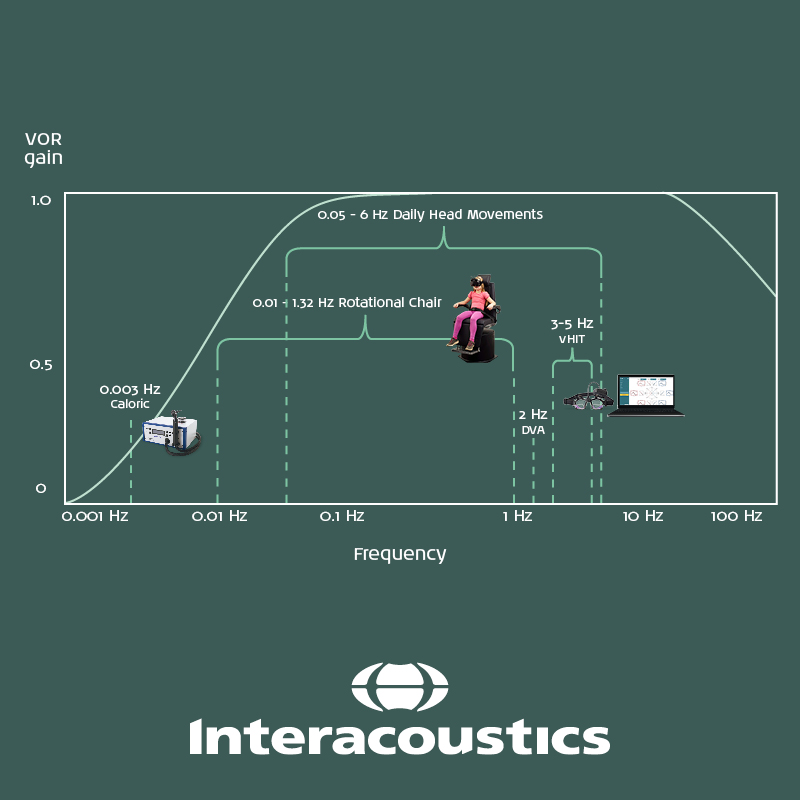Join the Interacoustics community and receive news about new products, events and much more
Is rotational chair testing really needed for a comprehensive vestibular assessment?
The idea of a rotational chair was first introduced by Robert Bárány in 1907 and has been used for a variety of different clinical needs since that time. However, newer vestibular tests, such as the video head impulse test (vHIT) and vestibular evoked myogenic potentials (VEMP), question whether the rotational chair test battery is still a necessary component for a comprehensive vestibular assessment.
The answer is yes, rotational chair testing provides very important clinical data that helps to diagnose dizziness disorders!
Clinical utility of rotational chair testing
The rotary chair exists to provide a standardized, reliable stimulus to elicit the vestibulo-ocular reflex (VOR). Utilizing electrodes or videonystagmography (VNG) goggles, clinicians are able to measure the gain, phase and symmetry of the VOR in response to different stimulus speeds.
Measurement of the VOR is critical for comprehensive evaluation of dizzy patients, as the VOR acts to stabilize gaze, especially while the head is in motion. There are many VOR tests that exist to evaluate across different frequencies or speeds of head movement.
See the chart in Figure 1 below for a graph of the available VOR tests. The lowest frequency VOR test is the caloric assessment, while the highest VOR test is the vHIT.

Reasons for the necessity of rotational chair testing
Rotational chair testing should be part of a comprehensive vestibular assessment for several reasons.
1. It is multi-frequency
Because our vestibular system has the ability to code many different frequencies (speeds) of movement, it is important our testing measures the function of our system at each of these speeds. We wouldn’t diagnose a hearing loss based on one frequency evaluated, so we shouldn’t do the same for vestibular!
Many vestibular disorders begin in the low frequencies, so rotational chair testing allows for clinicians to evaluate the extent of the impact of the disorder. But caloric testing is a low-frequency test, isn’t that good enough to evaluate for function or presence of disorders?
Actually, no! There are some disorders, such as disorders with a cerebellar pathology, that cause mid-to-high-frequency vestibular abnormalities. Therefore, the caloric response would be insufficient.
2. It evaluates compensation status
Unlike the caloric test response, rotational chair testing allows evaluation of compensation status. It provides gain, phase, and symmetry of the vestibulo-ocular reflex in response to different chair speeds. This allows for discrete information across the frequency spectrum.
In acute unilateral vestibular disorders, it is possible to have impacts on all three measurement parameters during sinusoidal harmonic acceleration (SHA) and step testing that improve with time or throughout rehabilitation.
In cases of ototoxic monitoring or monitoring of certain disorders (such as CANVAS), rotational chair test measurement parameters can evaluate for discrete changes and degradation of vestibular performance, which is often observed in gain reductions across frequencies.
3. It allows for evaluation of special populations
Many consider rotational chair testing as the gold standard for bilateral vestibular loss. However, it is also super beneficial in special populations to evaluate vestibular function, such as populations with active middle ear disorders and populations with neck mobility limitations.
Populations with active middle ear disorders
Caloric testing is a favorite vestibular test for many. However, a limiting factor for completion of this testing includes middle ear disorders, such as active ear infections or microtia.
As the caloric stimulus (air or water) needs to enter the ear canal and transfer through the middle ear space, anything blocking the effective temperature transfer of the stimulus through this space can produce an inaccurate response.
Rotational chair testing allows you to deliver an effective and standardized stimulus to the inner ear, without use of an air or water stimulus.
Populations with neck mobility limitations
The rotational chair stimulus is highly tolerable and is great for use in populations with neck mobility limitations who may not be candidates for vHIT testing.
4. It has high repeatability
The rotational stimulus is controlled and exact which allows for high repeatability between test sessions and dates. This standardized stimulus does not rely on the clinician’s technical ability or experience level.
Improve your vestibular test battery
By adding rotational chair testing to your vestibular test battery, you’re not only measuring extra and important data points on your patient’s vestibular performance, but you’re also widening the patient populations you can test.
For more information, visit Interacoustics’ Orion rotary chairs.
About the authors
Dr. Liz Fuemmeler, Au.D., is a Clinical Product Manager with Interacoustics and Vestibular Program Director at Professional Hearing Center in Kansas City, MO.
Dr. Michelle Petrak, Ph.D., is a Director of Clinical Research at Interacoustics. Her primary role is development and clinical validation of new technologies in the vestibular and balance areas.

Similar Topic
Stay up to date!
Subscribe to our newsletter and receive news on new products, seminars and much more.
By signing up, I accept to receive newsletter e-mails from Interacoustics. I can withdraw my consent at any time by using the ‘unsubscribe’-function included in each e-mail.
Click here and read our privacy notice, if you want to know more about how we treat and protect your personal data.
